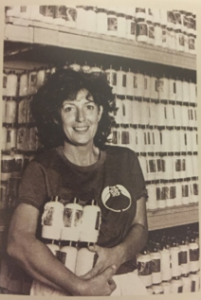To start the task, I decided to look within a book named ‘Women, A Century of lifestyle, Fashion, Work and Play’, by Maureen Hill. The Photograph I choose was of Dame Anita Roddick who founded the body shop. After doing further research into the Body Shop, I found that it was the first cosmetics brand to not test their products on animals. On the Body Shop website I discovered their business objectives in a company report. Which suggested that the company aim to support the community and to continue with their sustainable and ethical practice, with the additional promise to update the public on their progress and struggles.[1] This information is very useful as it enables us to find out about how the business is willing to change its practices and principles in order to become more ethical.

I then watched a video produced by the BBC, which argued there are controversial issues with The Body Shop. In 2006 the French cosmetics business L’Oreal took over The Body Shop. This is controversial as L’Oreal are not considered to be completely ethical or sustainable. Although, now they do not test on animals themselves, they are still not considered as being cruelty free due to the fact that their products are sold in China, where regulations do not prohibit the testing of products on animals before they reach the shelves.[2] Due to the fact that this information is sourced from the BBC one would therefore assume that it is fairly reliable.
After thoroughly researching The Body Shop, I was interested in its sustainable image, and how it can uses this as a unique selling point in the market. However, they are not alone, the clothing brand Reformation also follows such principles. Reformation was created in 2009 by Yael Aflalo. They use sustainable fabrics and vintage garments, but also incorporate ethical practices into their work. On their website, the fabrics they use, the percentage of their clothing that is made from vintage items and their efforts to be sustainable and better for the environment. They detail how their production methods are sustainable by tracking their own carbon footprint, and due to the fact that their factories and machineries are made to minimise waste and resources. In order to reduce their waste they send pre-paid shipping labels so when a customer has finished with their clothes they can send the clothes back to be recycled and reused.[3] The reliability of this website is questionable as it comes from the company itself, but the idea is revolutionary and an exciting venture for the prospects of environmentally friendly fashion.
To broaden my knowledge on sust ainable practices in businesses, I found a report published in 1992 by the ‘International Institute for Sustainable Development’ in conjunction with Deloitte & Touché and the ‘World Business Council for Sustainable Development.’[4] It is therefore one of the most reliable sources featured in this essay. The report defines what a sustainable business is and goes on to state which stakeholders are involved in creating a sustainable business. The report also shows the difficulties that comes with making a business sustainable. With the market being very dynamic, efforts to be sustainable can reduce the chance a business has to be competitive. This shows the effort and commitment certain sustainable businesses have, thus giving sustainable businesses a positive reputation. I enjoyed this research task and believe it may reflect upon my work in the future, and we can only hope that more businesses take up this sustainable mindset.
ainable practices in businesses, I found a report published in 1992 by the ‘International Institute for Sustainable Development’ in conjunction with Deloitte & Touché and the ‘World Business Council for Sustainable Development.’[4] It is therefore one of the most reliable sources featured in this essay. The report defines what a sustainable business is and goes on to state which stakeholders are involved in creating a sustainable business. The report also shows the difficulties that comes with making a business sustainable. With the market being very dynamic, efforts to be sustainable can reduce the chance a business has to be competitive. This shows the effort and commitment certain sustainable businesses have, thus giving sustainable businesses a positive reputation. I enjoyed this research task and believe it may reflect upon my work in the future, and we can only hope that more businesses take up this sustainable mindset.
The Body Shop, Building for the future, 2014/15. Accessed: 17/10/17 https://www.thebodyshop.com/medias/Values-Report-2015-6.pdf?context=pdf/ha8/h40/9089793032222.pdf&attachment=true
2What went wrong for The Body Shop?, BBC News, Kate Hope. 09/02/2017 Accessed 17/10/2017
. http://www.bbc.co.uk/news/business-38905530
3Reformation Clothing. Accessed 17/10/2017
https://www.thereformation.com
4 Business Strategies For sustainable Development , International Institute for Sustainable Development in conjunction with Deloitte & Touche and the World Business Council for Sustainable Development, 1992. Accessed 17/10/17
